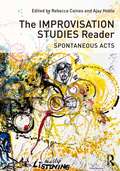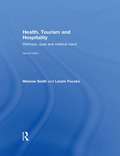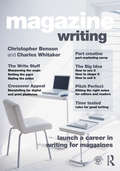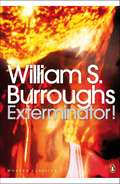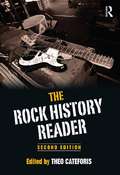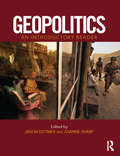- Table View
- List View
History of Art: A Student's Handbook
by Marcia PointonThis fully revised edition of the History of Art: A Student's Handbook introduces students to the kinds of practices, challenges, questions and writings they will encounter in studying the history of art. Marcia Pointon conveys the excitement of Art History as a multi-faceted discipline addressing all aspects of the study of media, communication and representation. She describes and analyses different methods and approaches to the discipline, explaining their history and their effects on the day-to-day learning process. She also discusses the relationship of Art History to related disciplines including film, literature, design history and anthropology. The fifth edition of this classic text includes: • information on why Art History is important and relevant in today’s world guidance on choosing a degree course case studies of careers pursued by Art History graduates advice on study skills and reading methods a bibliography and further reading detailed up to date advice on electronic resources and links to essential websites History of Art covers academic, training and vocational aspects of Art History, providing a wealth of information on the characteristics of courses available and on the relationship between Art History and the world of museums and heritage.
Classical Islam: A Sourcebook of Religious Literature
by Norman Calder Jawid Mojaddedi Andrew RippinThis definitive sourcebook presents more than sixty authoritative new translations of key Islamic texts. Edited and translated by three leading specialists, Classical Islam features eight thematically-linked sections covering the Qur'ān and its interpretation, the life of Muhammad, hadīth, law, theology, mysticism and Islamic history. The new edition has been expanded to cover a fuller range of material illustrating the growth of Islamic thought from its seventh-century origins through to the end of the medieval period. It includes illustrations, a glossary, extensive bibliography and explanatory prefaces for each text. Classical Islam is an essential resource for the study of early and medieval Islam and its legacy.
Classical Islam: A Sourcebook of Religious Literature
by Norman Calder Jawid Mojaddedi Andrew RippinThis definitive sourcebook presents more than sixty authoritative new translations of key Islamic texts. Edited and translated by three leading specialists, Classical Islam features eight thematically-linked sections covering the Qur'ān and its interpretation, the life of Muhammad, hadīth, law, theology, mysticism and Islamic history. The new edition has been expanded to cover a fuller range of material illustrating the growth of Islamic thought from its seventh-century origins through to the end of the medieval period. It includes illustrations, a glossary, extensive bibliography and explanatory prefaces for each text. Classical Islam is an essential resource for the study of early and medieval Islam and its legacy.
The Improvisation Studies Reader: Spontaneous Acts
by Ajay Heble Rebecca CainesImprovisation is a performance practice that animates and activates diverse energies of inspiration, critique, and invention. In recent years it has coalesced into an exciting and innovative new field of interdisciplinary scholarly inquiry, becoming a cornerstone of both practical and theoretical approaches to performance. The Improvisation Studies Reader draws together the works of key artists and thinkers from a range of disciplines, including theatre, music, literature, film, and dance. Divided by keywords into eight sections, this book bridges the gaps between these fields. The book includes case studies, exercises, graphic scores and poems in order to produce a teaching and research resource that identifies central themes in improvisation studies. The sections include: Listening Trust/Risk Flow Dissonance Responsibility Liveness Surprise Hope Each section of the Reader is introduced by a newly commissioned think piece by a key figure in the field, which opens up research questions reflecting on the keyword in question. By placing key theoretical and classic texts in conversation with cutting-edge research and artists’ statements, this book answers the urgent questions facing improvising artists and theorists in the mediatized Twenty-First Century.
The Improvisation Studies Reader: Spontaneous Acts
by Ajay Heble Rebecca CainesImprovisation is a performance practice that animates and activates diverse energies of inspiration, critique, and invention. In recent years it has coalesced into an exciting and innovative new field of interdisciplinary scholarly inquiry, becoming a cornerstone of both practical and theoretical approaches to performance. The Improvisation Studies Reader draws together the works of key artists and thinkers from a range of disciplines, including theatre, music, literature, film, and dance. Divided by keywords into eight sections, this book bridges the gaps between these fields. The book includes case studies, exercises, graphic scores and poems in order to produce a teaching and research resource that identifies central themes in improvisation studies. The sections include: Listening Trust/Risk Flow Dissonance Responsibility Liveness Surprise Hope Each section of the Reader is introduced by a newly commissioned think piece by a key figure in the field, which opens up research questions reflecting on the keyword in question. By placing key theoretical and classic texts in conversation with cutting-edge research and artists’ statements, this book answers the urgent questions facing improvising artists and theorists in the mediatized Twenty-First Century.
Health, Tourism and Hospitality: Spas, Wellness and Medical Travel
by Melanie Smith Laszlo PuczkoHealth, Tourism and Hospitality: Spas, Wellness and Medical Travel, 2nd Edition takes an in-depth and comprehensive look at the growing health, wellness and medical tourism sectors in a global context. The book analyses the history and development of the industries, the way in which they are managed and organised, the expanding range of new and innovative products and trends, and the marketing of destinations, products and services. The only book to offer a complete overview and introduction to health, tourism and hospitality this 2nd Edition has been updated to include: • Expanded coverage to the hospitality sector with a particular focus on spa management.• New content on medical tourism throughout the book, to reflect the worldwide growth in medical travel with more and more countries entering this competitive market.• Updated content to reflect recent issues and trends including: ageing population, governments encouraging preventative health, consumer use of contemporary and alternative therapies, self-help market, impacts of economic recession, spa management and customer loyalty.• New case studies taken from a range of different countries and contexts, and focusing on established or new destinations, products and services such as: conventional medicine, complementary and alternative therapies, lifestyle-based wellness, beauty and cosmetics, healthy nutrition, longevity and anti (or active)-ageing, amongst others. Written in a user friendly style, this is essential reading for students studying health, tourism and hospitality.
Health, Tourism and Hospitality: Spas, Wellness and Medical Travel
by Melanie Smith Laszlo PuczkoHealth, Tourism and Hospitality: Spas, Wellness and Medical Travel, 2nd Edition takes an in-depth and comprehensive look at the growing health, wellness and medical tourism sectors in a global context. The book analyses the history and development of the industries, the way in which they are managed and organised, the expanding range of new and innovative products and trends, and the marketing of destinations, products and services. The only book to offer a complete overview and introduction to health, tourism and hospitality this 2nd Edition has been updated to include: • Expanded coverage to the hospitality sector with a particular focus on spa management.• New content on medical tourism throughout the book, to reflect the worldwide growth in medical travel with more and more countries entering this competitive market.• Updated content to reflect recent issues and trends including: ageing population, governments encouraging preventative health, consumer use of contemporary and alternative therapies, self-help market, impacts of economic recession, spa management and customer loyalty.• New case studies taken from a range of different countries and contexts, and focusing on established or new destinations, products and services such as: conventional medicine, complementary and alternative therapies, lifestyle-based wellness, beauty and cosmetics, healthy nutrition, longevity and anti (or active)-ageing, amongst others. Written in a user friendly style, this is essential reading for students studying health, tourism and hospitality.
Q&A European Union Law 2013-2014 (Questions and Answers)
by Michael CuthbertRoutledge Q&As give you the tools to practice and refine your exam technique, showing you how to apply your knowledge to maximum effect in an exam situation. Each book contains up to fifty essay and problem-based questions on the most commonly examined topics, complete with expert guidance and fully worked model answers. These new editions for 2013-2014 will provide you with the skills you need for your exams by: Helping you to be prepared: each title in the series has an introduction presenting carefully tailored advice on how to approach assessment for your subject Showing you what examiners are looking for: each question is annotated with both a short overview on how to approach your answer, as well as footnoted commentary that demonstrate how model answers meet marking criteria Offering pointers on how to gain marks, as well as what common errors could lose them: ‘Aim Higher’ and ‘Common Pitfalls’ offer crucial guidance throughout Helping you to understand and remember the law: diagrams for each answer work to illuminate difficult legal principles and provide overviews of how model answers are structured Books in the series are also supported by a Companion Website that offers online essay-writing tutorials, podcasts, bonus Q&As and multiple-choice questions to help you focus your revision more effectively.
Q&A European Union Law 2013-2014 (Questions and Answers)
by Michael CuthbertRoutledge Q&As give you the tools to practice and refine your exam technique, showing you how to apply your knowledge to maximum effect in an exam situation. Each book contains up to fifty essay and problem-based questions on the most commonly examined topics, complete with expert guidance and fully worked model answers. These new editions for 2013-2014 will provide you with the skills you need for your exams by: Helping you to be prepared: each title in the series has an introduction presenting carefully tailored advice on how to approach assessment for your subject Showing you what examiners are looking for: each question is annotated with both a short overview on how to approach your answer, as well as footnoted commentary that demonstrate how model answers meet marking criteria Offering pointers on how to gain marks, as well as what common errors could lose them: ‘Aim Higher’ and ‘Common Pitfalls’ offer crucial guidance throughout Helping you to understand and remember the law: diagrams for each answer work to illuminate difficult legal principles and provide overviews of how model answers are structured Books in the series are also supported by a Companion Website that offers online essay-writing tutorials, podcasts, bonus Q&As and multiple-choice questions to help you focus your revision more effectively.
Q&A Employment Law 2013-2014 (Questions and Answers)
by Deborah LocktonRoutledge Q&As give you the tools to practice and refine your exam technique, showing you how to apply your knowledge to maximum effect in an exam situation. Each book contains up to fifty essay and problem-based questions on the most commonly examined topics, complete with expert guidance and fully worked model answers. These new editions for 2013-2014 will provide you with the skills you need for your exams by: Helping you to be prepared: each title in the series has an introduction presenting carefully tailored advice on how to approach assessment for your subject Showing you what examiners are looking for: each question is annotated with both a short overview on how to approach your answer, as well as footnoted commentary that demonstrate how model answers meet marking criteria Offering pointers on how to gain marks, as well as what common errors could lose them: ‘Aim Higher’ and ‘Common Pitfalls’ offer crucial guidance throughout Helping you to understand and remember the law: diagrams for each answer work to illuminate difficult legal principles and provide overviews of how model answers are structured Books in the series are also supported by a Companion Website that offers online essay-writing tutorials, podcasts, bonus Q&As and multiple-choice questions to help you focus your revision more effectively.
Q&A Employment Law 2013-2014 (Questions and Answers)
by Deborah LocktonRoutledge Q&As give you the tools to practice and refine your exam technique, showing you how to apply your knowledge to maximum effect in an exam situation. Each book contains up to fifty essay and problem-based questions on the most commonly examined topics, complete with expert guidance and fully worked model answers. These new editions for 2013-2014 will provide you with the skills you need for your exams by: Helping you to be prepared: each title in the series has an introduction presenting carefully tailored advice on how to approach assessment for your subject Showing you what examiners are looking for: each question is annotated with both a short overview on how to approach your answer, as well as footnoted commentary that demonstrate how model answers meet marking criteria Offering pointers on how to gain marks, as well as what common errors could lose them: ‘Aim Higher’ and ‘Common Pitfalls’ offer crucial guidance throughout Helping you to understand and remember the law: diagrams for each answer work to illuminate difficult legal principles and provide overviews of how model answers are structured Books in the series are also supported by a Companion Website that offers online essay-writing tutorials, podcasts, bonus Q&As and multiple-choice questions to help you focus your revision more effectively.
Q&A Civil Liberties & Human Rights 2013-2014 (Questions and Answers)
by Helen Fenwick Richard GlanceyRoutledge Q&As give you the tools to practice and refine your exam technique, showing you how to apply your knowledge to maximum effect in an exam situation. Each book contains up to fifty essay and problem-based questions on the most commonly examined topics, complete with expert guidance and fully worked model answers. These new editions for 2013-2014 will provide you with the skills you need for your exams by: Helping you to be prepared: each title in the series has an introduction presenting carefully tailored advice on how to approach assessment for your subject Showing you what examiners are looking for: each question is annotated with both a short overview on how to approach your answer, as well as footnoted commentary that demonstrate how model answers meet marking criteria Offering pointers on how to gain marks, as well as what common errors could lose them: ‘Aim Higher’ and ‘Common Pitfalls’ offer crucial guidance throughout Helping you to understand and remember the law: diagrams for each answer work to illuminate difficult legal principles and provide overviews of how model answers are structured Books in the series are also supported by a Companion Website that offers online essay-writing tutorials, podcasts, bonus Q&As and multiple-choice questions to help you focus your revision more effectively.
Q&A Civil Liberties & Human Rights 2013-2014 (Questions and Answers)
by Helen Fenwick Richard GlanceyRoutledge Q&As give you the tools to practice and refine your exam technique, showing you how to apply your knowledge to maximum effect in an exam situation. Each book contains up to fifty essay and problem-based questions on the most commonly examined topics, complete with expert guidance and fully worked model answers. These new editions for 2013-2014 will provide you with the skills you need for your exams by: Helping you to be prepared: each title in the series has an introduction presenting carefully tailored advice on how to approach assessment for your subject Showing you what examiners are looking for: each question is annotated with both a short overview on how to approach your answer, as well as footnoted commentary that demonstrate how model answers meet marking criteria Offering pointers on how to gain marks, as well as what common errors could lose them: ‘Aim Higher’ and ‘Common Pitfalls’ offer crucial guidance throughout Helping you to understand and remember the law: diagrams for each answer work to illuminate difficult legal principles and provide overviews of how model answers are structured Books in the series are also supported by a Companion Website that offers online essay-writing tutorials, podcasts, bonus Q&As and multiple-choice questions to help you focus your revision more effectively.
Magazine Writing
by Christopher D. Benson Charles F. WhitakerWhat does it take to launch a career writing for magazines? In this comprehensive, up-to-date introduction to magazine writing, students will learn everything from the initial story pitch all the way through to the final production, taking with them the essential tools and skills they will need for today’s rapidly changing media landscape. Written by a team of experienced writers and editors, Magazine Writing teaches the time-tested rules for good writing alongside the modern tools for digital storytelling. From service pieces to profiles, entertainment stories and travel articles, it provides expert guidance on topics such as: developing saleable ideas; appealing to specific segments of the market; navigating a successful pitch; writing and editing content for a variety of areas, including service, profiles, entertainment, travel, human interest and enterprise Chock full of examples of published works, conversations with successful magazine contributors and bloggers, and interviews with working editors, Magazine Writing gives students all the practical and necessary insights they need to jumpstart a successful magazine writing career.
Exterminator! (Penguin Modern Classics)
by William S. BurroughsA man, dispirited by ageing, endeavours to steal a younger man’s face; a doctor yearns for a virus that might eliminate his discomfort by turning everyone else into doubles of himself; a Colonel lays out the precepts of the life of DE (Do Easy); conspirators posthumously succeed in blowing up a train full of nerve gas; a mandrill known as the Purple Better One runs for the presidency with brutal results; and the world drifts towards apocalypses of violence, climate and plague. The hallucinatory landscape of William Burroughs’ compellingly bizarre, fragmented novel is constantly shifting, something sinister always just beneath the surface.
Magazine Writing
by Christopher D. Benson Charles F. WhitakerWhat does it take to launch a career writing for magazines? In this comprehensive, up-to-date introduction to magazine writing, students will learn everything from the initial story pitch all the way through to the final production, taking with them the essential tools and skills they will need for today’s rapidly changing media landscape. Written by a team of experienced writers and editors, Magazine Writing teaches the time-tested rules for good writing alongside the modern tools for digital storytelling. From service pieces to profiles, entertainment stories and travel articles, it provides expert guidance on topics such as: developing saleable ideas; appealing to specific segments of the market; navigating a successful pitch; writing and editing content for a variety of areas, including service, profiles, entertainment, travel, human interest and enterprise Chock full of examples of published works, conversations with successful magazine contributors and bloggers, and interviews with working editors, Magazine Writing gives students all the practical and necessary insights they need to jumpstart a successful magazine writing career.
Principles of Research in Behavioral Science: Third Edition
by Bernard E. Whitley Jr. Mary E. KiteIntended for beginning graduate or advanced undergraduate students, this book provides a comprehensive review of research methods used in psychology and related disciplines. It covers topics that are often omitted in other texts including correlational and qualitative research and integrative literature reviews. Basic principles are reviewed for those who need a refresher. The focus is on conceptual issues – statistics are kept to a minimum. Featuring examples from all fields of psychology, the book addresses laboratory and field research. Chapters are written to be used independently, so instructors can pick and choose those that fit their course needs. Reorganized to parallel the steps of the research process, tips on writing reports are also provided. Each chapter features an outline, key terms, a summary, and questions and exercises that integrate chapter topics and put theory into practice. A glossary and an annotated list of readings are now included. Extensively updated throughout, the new edition features a new co-author, Mary Kite, and:• New chapters on qualitative research and content analysis and another on integrative literature reviews including meta-analysis, critical techniques for today’s research environment. • A new chapter on exploratory and confirmatory factor analysis that addresses the use of path analysis and structural equation modeling. • A new chapter on how to write a research report using APA style.• Examples from cross-cultural and multi-cultural research, neuroscience, cognitive, and developmental psychology along with ones from social, industrial, and clinical psychology. • More on Internet research and studies.• Greatly expanded Part 3 on research designs with chapters on true experiments, field research, correlational and single-case designs, content analysis, and survey and qualitative research.• A website with PowerPoint slides for each chapter, a test bank with short answer and multiple choice questions, additional teaching resources, and the tables and figures from the book for Instructor’s and chapter outlines, suggested readings, and links to related web sites for students. Intended as a text for beginning graduate and/or advanced undergraduate courses in research methods or experimental methods or design taught in psychology, human development, family studies, education, or other social and behavioral sciences, a prerequisite of undergraduate statistics and a beginning research methods course is assumed.
The Rock History Reader
by Theo CateforisThe Rock History Reader is an eclectic compilation of readings that tells the history of rock as it has been received and explained as a social and musical practice throughout its six decade history. The readings range from the vivid autobiographical accounts of such rock icons as Ronnie Spector and David Lee Roth to the writings of noted rock critics like Lester Bangs and Chuck Klosterman. It also includes a variety of selections from media critics, musicologists, fanzine writers, legal experts, sociologists and prominent political figures. Many entries also deal specifically with distinctive styles such as Motown, punk, disco, grunge, rap and indie rock. Each entry includes headnotes, which place it in its historical context. This second edition includes new readings on the early years of rhythm & blues and rock ‘n’ roll, as well as entries on payola, mods, the rise of FM rock, progressive rock and the PMRC congressional hearings. In addition, there is a wealth of new material on the 2000s that explores such relatively recent developments as emo, mash ups, the explosion of internet culture and new media, and iconic figures like Radiohead and Lady Gaga. With numerous readings that delve into the often explosive issues surrounding censorship, copyright, race relations, feminism, youth subcultures, and the meaning of musical value, The Rock History Reader continues to appeal to scholars and students from a variety of disciplines.
The Rock History Reader
by Theo CateforisThe Rock History Reader is an eclectic compilation of readings that tells the history of rock as it has been received and explained as a social and musical practice throughout its six decade history. The readings range from the vivid autobiographical accounts of such rock icons as Ronnie Spector and David Lee Roth to the writings of noted rock critics like Lester Bangs and Chuck Klosterman. It also includes a variety of selections from media critics, musicologists, fanzine writers, legal experts, sociologists and prominent political figures. Many entries also deal specifically with distinctive styles such as Motown, punk, disco, grunge, rap and indie rock. Each entry includes headnotes, which place it in its historical context. This second edition includes new readings on the early years of rhythm & blues and rock ‘n’ roll, as well as entries on payola, mods, the rise of FM rock, progressive rock and the PMRC congressional hearings. In addition, there is a wealth of new material on the 2000s that explores such relatively recent developments as emo, mash ups, the explosion of internet culture and new media, and iconic figures like Radiohead and Lady Gaga. With numerous readings that delve into the often explosive issues surrounding censorship, copyright, race relations, feminism, youth subcultures, and the meaning of musical value, The Rock History Reader continues to appeal to scholars and students from a variety of disciplines.
An Introduction to Political Geography: Space, Place and Politics
by Martin Jones Rhys Jones Michael Woods Mark Whitehead Deborah Dixon Matthew HannahAn Introduction to Political Geography continues to provide a broad-based introduction to contemporary political geography for students following undergraduate degree courses in geography and related subjects. The text explores the full breadth of contemporary political geography, covering not only traditional concerns such as the state, geopolitics, electoral geography and nationalism; but also increasing important areas at the cutting-edge of political geography research including globalization, the geographies of regulation and governance, geographies of policy formulation and delivery, and themes at the intersection of political and cultural geography, including the politics of place consumption, landscapes of power, citizenship, identity politics and geographies of mobilization and resistance. This second edition builds on the strengths of the first. The main changes and enhancements are: four new chapters on: political geographies of globalization, geographies of empire, political geography and the environment and geopolitics and critical geopolitics significant updating and revision of the existing chapters to discuss key developments, drawing on recent academic contributions and political events new case studies, drawing on an increasing number of international and global examples additional boxes for key concepts and an enlarged glossary. As with the first edition, extensive use is made of case study examples, illustrations, explanatory boxes, guides to further reading and a glossary of key terms to present the material in an easily accessible manner. Through employment of these techniques this book introduces students to contributions from a range of social and political theories in the context of empirical case study examples. By providing a basic introduction to such concepts and pointing to pathways into more specialist material, this book serves both as a core text for first- and second- year courses in political geography, and as a resource alongside supplementary textbooks for more specialist third year courses.
An Introduction to Political Geography: Space, Place and Politics
by Martin Jones Rhys Jones Michael Woods Mark Whitehead Deborah Dixon Matthew HannahAn Introduction to Political Geography continues to provide a broad-based introduction to contemporary political geography for students following undergraduate degree courses in geography and related subjects. The text explores the full breadth of contemporary political geography, covering not only traditional concerns such as the state, geopolitics, electoral geography and nationalism; but also increasing important areas at the cutting-edge of political geography research including globalization, the geographies of regulation and governance, geographies of policy formulation and delivery, and themes at the intersection of political and cultural geography, including the politics of place consumption, landscapes of power, citizenship, identity politics and geographies of mobilization and resistance. This second edition builds on the strengths of the first. The main changes and enhancements are: four new chapters on: political geographies of globalization, geographies of empire, political geography and the environment and geopolitics and critical geopolitics significant updating and revision of the existing chapters to discuss key developments, drawing on recent academic contributions and political events new case studies, drawing on an increasing number of international and global examples additional boxes for key concepts and an enlarged glossary. As with the first edition, extensive use is made of case study examples, illustrations, explanatory boxes, guides to further reading and a glossary of key terms to present the material in an easily accessible manner. Through employment of these techniques this book introduces students to contributions from a range of social and political theories in the context of empirical case study examples. By providing a basic introduction to such concepts and pointing to pathways into more specialist material, this book serves both as a core text for first- and second- year courses in political geography, and as a resource alongside supplementary textbooks for more specialist third year courses.
Geopolitics: An Introductory Reader (Critical Geopolitics)
by Jason Dittmer Jo SharpIt has been increasingly impossible to think about our changing world without coming across the term 'geopolitics'. In the wake of the invasion and occupation of Iraq by the United States, United Kingdom, and others, geopolitics has been offered as an explanation for the occupation's failure to reinvent the Iraqi state and as a blueprint for future action. But what is 'geopolitics'? Drawing both on academic and political material, this book introduces readers to the concept of geopolitics, from the first usage of the term to its more recent reconceptualisations. The concept of geopolitics is introduced through four thematic sections - Imperial Geopolitics, Cold War Geopolitics, Geopolitics after the Cold War and Reconceptualising Geopolitics. Each section includes key writings from a range of diverse and leading authors such as Said, Agnew, Dalby, O Tuathail, Gregory, Barnett and Kaplan, and is accompanied by a critical introduction by the editors to guide the reader through the material. This Reader establishes the foundations of geopolitics while also introducing readers to the continuing significance of the concept in the 21st century. This Reader provides an essential resource that exposes students to original writing. The Editors provide a pathway through the material with Section Introductions to assist the readers understanding of the context of the material and impacts of the writings. The readings included draw from a range of authors, writing from a range of locations. The Reader concludes with the latest changes in geopolitical thought, incorporating feminist and other perspectives.
Geopolitics: An Introductory Reader
by Jason Dittmer Jo SharpIt has been increasingly impossible to think about our changing world without coming across the term 'geopolitics'. In the wake of the invasion and occupation of Iraq by the United States, United Kingdom, and others, geopolitics has been offered as an explanation for the occupation's failure to reinvent the Iraqi state and as a blueprint for future action. But what is 'geopolitics'? Drawing both on academic and political material, this book introduces readers to the concept of geopolitics, from the first usage of the term to its more recent reconceptualisations. The concept of geopolitics is introduced through four thematic sections - Imperial Geopolitics, Cold War Geopolitics, Geopolitics after the Cold War and Reconceptualising Geopolitics. Each section includes key writings from a range of diverse and leading authors such as Said, Agnew, Dalby, O Tuathail, Gregory, Barnett and Kaplan, and is accompanied by a critical introduction by the editors to guide the reader through the material. This Reader establishes the foundations of geopolitics while also introducing readers to the continuing significance of the concept in the 21st century. This Reader provides an essential resource that exposes students to original writing. The Editors provide a pathway through the material with Section Introductions to assist the readers understanding of the context of the material and impacts of the writings. The readings included draw from a range of authors, writing from a range of locations. The Reader concludes with the latest changes in geopolitical thought, incorporating feminist and other perspectives.
The Urban Design Reader (Routledge Urban Reader Series)
by Michael Larice Elizabeth MacdonaldThe second edition of The Urban Design Reader draws together the very best of classic and contemporary writings to illuminate and expand the theory and practice of urban design. Nearly 50 generous selections include seminal contributions from Howard, Le Corbusier, Lynch, and Jacobs to more recent writings by Waldheim, Koolhaas, and Sorkin. Following the widespread success of the first edition of The Urban Design Reader, this updated edition continues to provide the most important historical material of the urban design field, but also introduces new topics and selections that address the myriad challenges facing designers today. The six part structure of the second edition guides the reader through the history, theory and practice of urban design. The reader is initially introduced to those classic writings that provide the historical precedents for city-making into the twentieth century. Part Two introduces the voices and ideas that were instrumental in establishing the foundations of the urban design field from the late 1950s up to the mid-1990s. These authors present a critical reading of the design professions and offer an alternative urban design agenda focused on vital and lively places. The authors in Part Three provide a range of urban design rationales and strategies for reinforcing local physical identity and the creation of memorable places. These selections are largely describing the outcomes of mid-century urban design and voicing concerns over the placeless quality of contemporary urbanism. The fourth part of the Reader explores key issues in urban design and development. Ideas about sprawl, density, community health, public space and everyday life are the primary focus here. Several new selections in this part of the book also highlight important international development trends in the Middle East and China. Part Five presents environmental challenges faced by the built environment professions today, including recent material on landscape urbanism, sustainability, and urban resiliency. The final part examines professional practice and current debates in the field: where urban designers work, what they do, their roles, their fields of knowledge and their educational development. The section concludes with several position pieces and debates on the future of urban design practice. This book provides an essential resource for students and practitioners of urban design, drawing together important but widely dispersed writings. Part and section introductions are provided to assist readers in understanding the context of the material, summary messages, impacts of the writing, and how they fit into the larger picture of the urban design field.
The Urban Design Reader (Routledge Urban Reader Series)
by Michael Larice Elizabeth MacdonaldThe second edition of The Urban Design Reader draws together the very best of classic and contemporary writings to illuminate and expand the theory and practice of urban design. Nearly 50 generous selections include seminal contributions from Howard, Le Corbusier, Lynch, and Jacobs to more recent writings by Waldheim, Koolhaas, and Sorkin. Following the widespread success of the first edition of The Urban Design Reader, this updated edition continues to provide the most important historical material of the urban design field, but also introduces new topics and selections that address the myriad challenges facing designers today. The six part structure of the second edition guides the reader through the history, theory and practice of urban design. The reader is initially introduced to those classic writings that provide the historical precedents for city-making into the twentieth century. Part Two introduces the voices and ideas that were instrumental in establishing the foundations of the urban design field from the late 1950s up to the mid-1990s. These authors present a critical reading of the design professions and offer an alternative urban design agenda focused on vital and lively places. The authors in Part Three provide a range of urban design rationales and strategies for reinforcing local physical identity and the creation of memorable places. These selections are largely describing the outcomes of mid-century urban design and voicing concerns over the placeless quality of contemporary urbanism. The fourth part of the Reader explores key issues in urban design and development. Ideas about sprawl, density, community health, public space and everyday life are the primary focus here. Several new selections in this part of the book also highlight important international development trends in the Middle East and China. Part Five presents environmental challenges faced by the built environment professions today, including recent material on landscape urbanism, sustainability, and urban resiliency. The final part examines professional practice and current debates in the field: where urban designers work, what they do, their roles, their fields of knowledge and their educational development. The section concludes with several position pieces and debates on the future of urban design practice. This book provides an essential resource for students and practitioners of urban design, drawing together important but widely dispersed writings. Part and section introductions are provided to assist readers in understanding the context of the material, summary messages, impacts of the writing, and how they fit into the larger picture of the urban design field.



